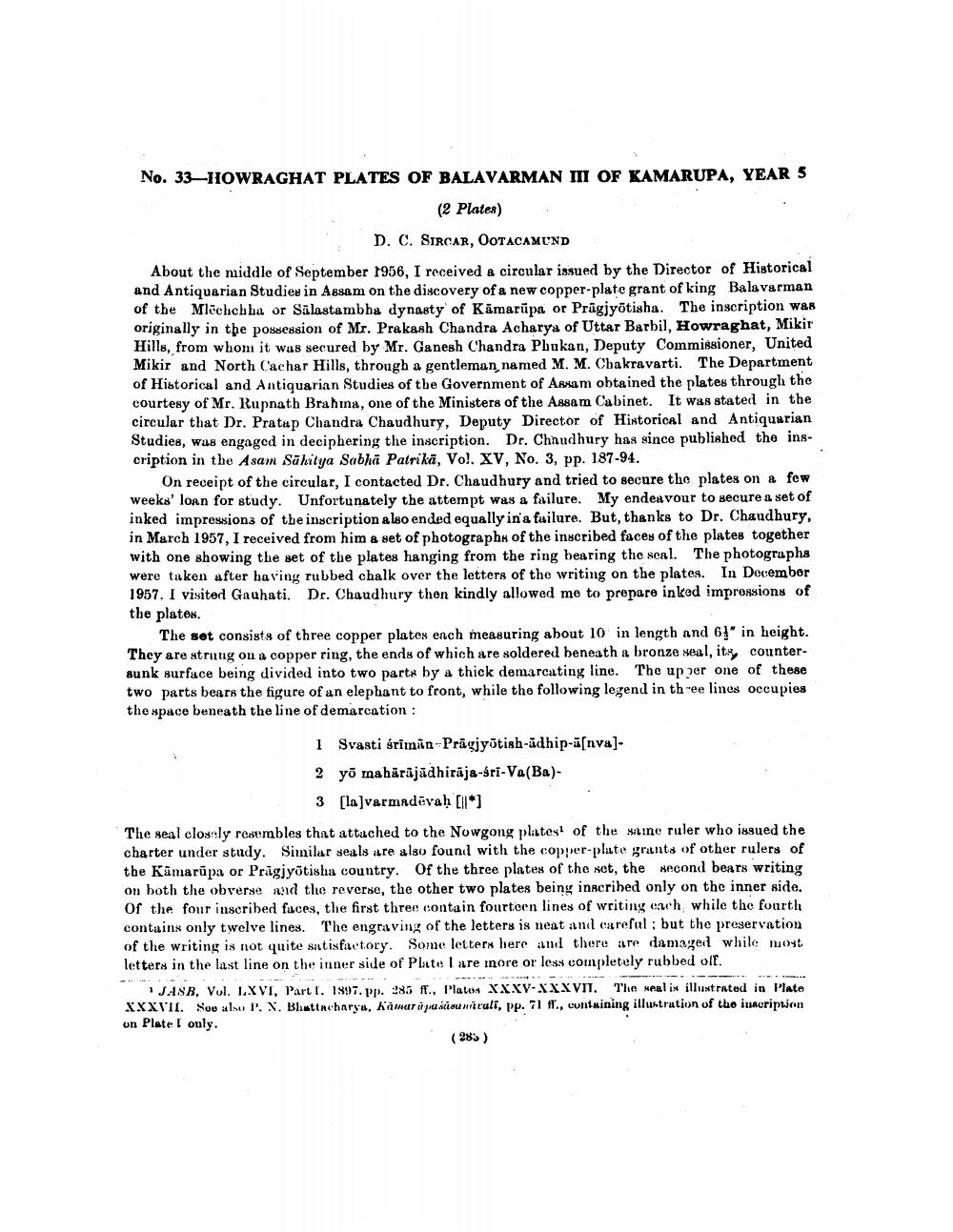________________
No. 33—HOWRAGHAT PLATES OF BALAVARMAN II OF KAMARUPA, YEAR 5
(2 Plates)
D. C. SIRCAR, OOTACAMUND About the middle of September 1956, I received a circular issued by the Director of Historical and Antiquarian Studies in Assam on the discovery of a new copper-plate grant of king Balavarman of the Mlochchha or Salastambha dynasty of Kämarūpa or Prügjyotisha. The inscription was originally in the possession of Mr. Prakash Chandra Acharya of Uttar Barbil, Howraghat, Mikir Hills, from whom it was secured by Mr. Ganesh Chandra Phukan, Deputy Commissioner, United Mikir and North Cachar Hills, through a gentleman named M. M. Chakravarti. The Department of Historical and Antiquarian Studies of the Government of Assam obtained the plates through the courtesy of Mr. Rupnath Brahma, one of the Ministers of the Assam Cabinet. It was stated in the circular that Dr. Pratap Chandra Chaudhury, Deputy Director of Historical and Antiquarian Studies, was engaged in deciphering the inscription. Dr. Chnudhury has since published the inscription in the Asam Sahitya Sabha Patrika, Vol. XV, No. 3, pp. 187-94.
On receipt of the circular, I contacted Dr. Chaudhury and tried to secure the plates on a few weeks' loan for study. Unfortunately the attempt was a failure. My endeavour to secure a set of inked impressions of the inscription also ended equally in'a failure. But, thanks to Dr. Chaudhury, in March 1957, I received from him a set of photographs of the inscribed faces of the plates together with one showing the set of the plates hanging from the ring hearing the scal. The photographs were taken after having rubbed chalk over the letters of the writing on the plates. In December 1957. I visited Gauhati. Dr. Chaudhury then kindly allowed me to prepare inked impressions of the plates.
The set consists of three copper platos ench measuring about 10 in length and 6}" in height. They are string on a copper ring, the ends of which are soldered beneath a bronze neal, its, countersunk surface being divided into two parts by a thick demarcating line. The upper one of these two parts bears the figure of an elephant to front, while the following legend in three lines occupies the space beneath the line of demarcation :
1 Svasti srimin-Prāgjyotish-udhip-u[nval2 yo mahārājādhiraja-sri-Va(Ba)
3 [la]varmadevah (il*] The seal closely resembles that attached to the Nowgong platest of the siline ruler who issued the charter under study. Similar seals are also found with the copper-plate grants of other rulers of the Kamarūpa or Prigjyotisha country. Of the three plates of the set, the second bears writing on both the obverse and the reverse, the other two plates being inscribed only on the inner side. of the four inscribed faces, the first three contain fourteen lines of writing each while the fourth contains only twelve lines. The engraving of the letters is neat and careful; but the preservation of the writing is not quite satisfactory. Some letters here and there are damaged while nost letters in the last line on the inner side of Plate I are inore or less completely rubbed off.
JANB, Vol. I.XVI, Part I. 1997. Pp. 185 ff., Platos XX.XV-XXXVII. The seal is illustrated in Plato XXXVII. Soo also P. X. Bluttacharya, kamur pususunaculi, pp. 71 fl., containing illustration of the inscription on Plate I only.
( 283 )




